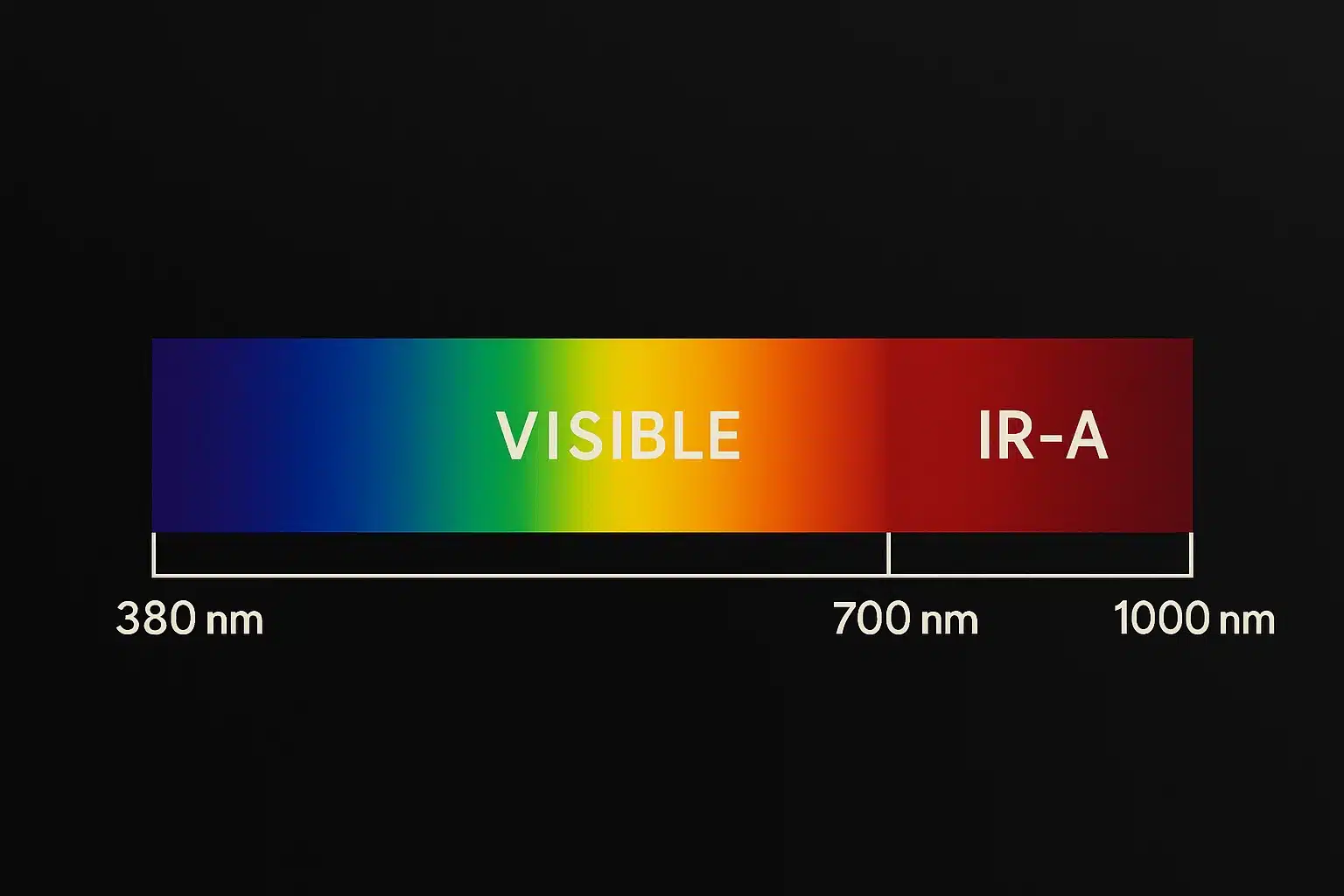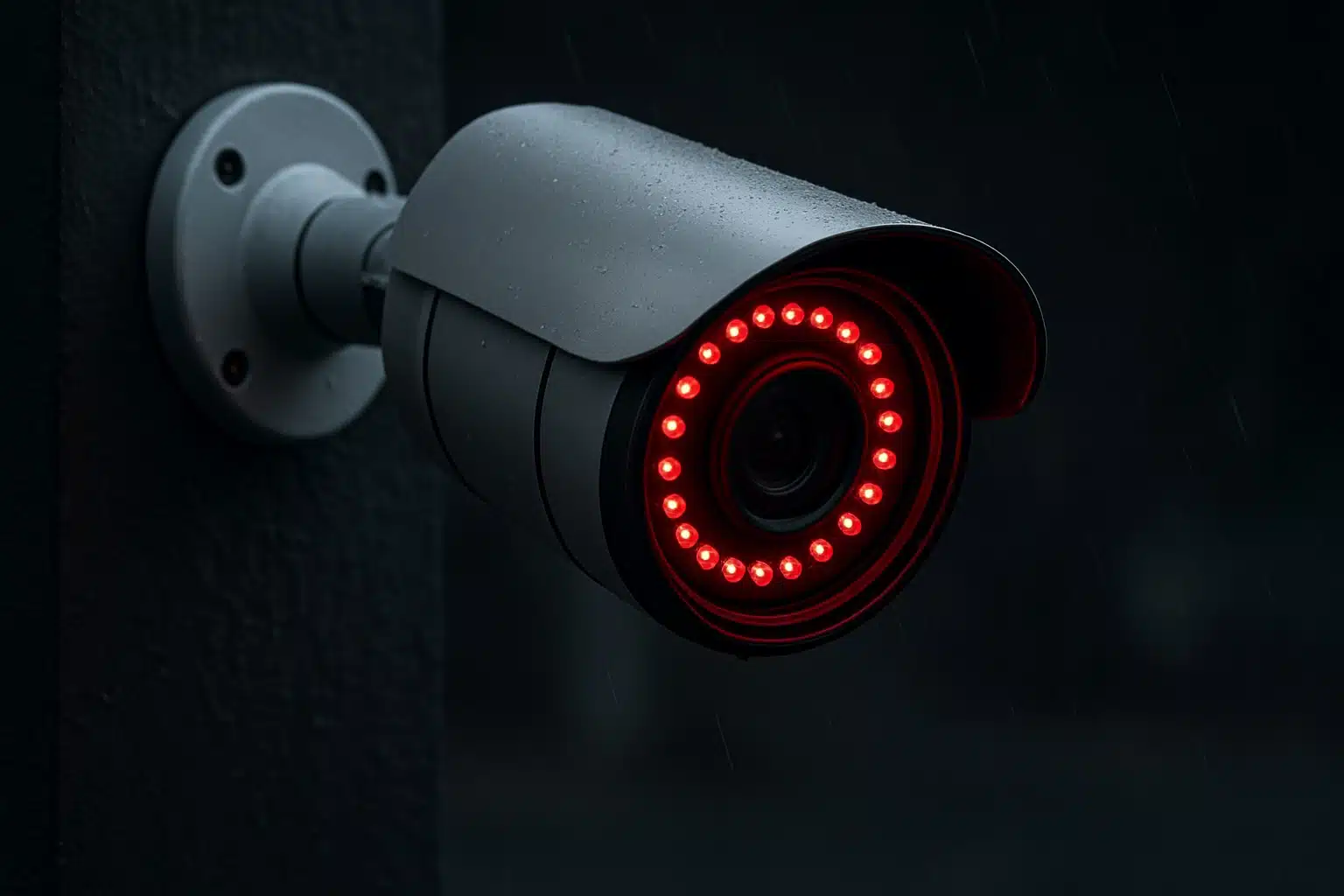On a recent site visit to a high-security facility, I noticed a faint red glow surrounding a surveillance camera at night. This light wasn’t from a bulb or laser but from an array of 850 nm near-infrared LEDs providing illumination invisible to the human eye. In simple terms, Near-infrared (NIR) LEDs are essential light sources in various applications. are light-emitting diodes engineered to emit photons just beyond the visible spectrum. Though we can’t see their beam, specialized sensors and cameras detect this NIR light to capture images in total darkness.
Infrared (IR) light lies immediately beyond visible red light, starting around 700 nm. In fact, Tech-LED’s IR/NIR product page defines IR-A (near IR) as roughly 700–1400 nm, which includes both near-infrared and short-wavelength infrared.source). In practice, most NIR LEDs emit at wavelengths up to ~1000 nm, with common peaks at about 730 nm, 850 nm, 880 nm, and 940 nm. These wavelengths are invisible to our eyes but useful for night vision, sensing, and communication.
Near-Infrared Defined
Near-infrared refers to the portion of the infrared spectrum closest to visible light. Infrared itself is all wavelengths beyond ~700 nm (beyond visible red), including near-infrared and short-wavelength infrared. The near-IR band (IR-A) spans roughly 700–1400 nm (Tech-LED’s IR/NIR product page). Because NIR LEDs must be detectable by silicon sensors, they rarely exceed ~1000 nm; longer wavelengths (mid/far IR) typically require different materials due to their absorption characteristics. In practical terms, once you pass ~700 nm, the light becomes invisible to our eyes.
How NIR LEDs Work
Near-infrared LEDs operate like other LEDs: they rely on a semiconductor PN junction. Passing a current through the diode forces electrons and holes to recombine, emitting photons (a process called Electroluminescence is a phenomenon that occurs in materials used for near-infrared light emission. The emitted photon’s wavelength depends on the semiconductor’s bandgap. For NIR, manufacturers use materials like gallium arsenide (GaAs) or gallium aluminum arsenide tuned to emit lower-energy infrared photons. In essence, an IR LED “works by pumping electrical current through a semiconductor junction, causing it to emit light at wavelengths longer than ~700 nm” (same physics as a normal LED).
- Forward voltage & current: Most NIR LEDs require only ~1.2–1.8 V forward voltage. Typical drive currents are around 50–100 mA continuous. For example, an 850 nm LED might draw 50 mA at ~1.5 V. These diodes can be driven with pulses up to ~1 A for short bursts. Always use a constant-current driver to avoid overheating.
- Output: An 850 nm LED can emit on the order of tens of milliwatts at 50 mA. In contrast, a 940 nm LED of similar size might produce somewhat less power than a comparable infrared laser. Tech-LED notes that 850 nm devices (AlGaAs) typically have higher output than 940 nm devices. The slight red glow of an 850 nm LED indicates higher efficiency; 940 nm LEDs produce no visible glow.
Common Types of NIR LEDs
Nearly all NIR LEDs fall into a few standard wavelengths:
- ~850 nm LEDs: These are extremely common for illumination. An 850 nm LED can produce around 20–30 mW at 50 mA in a small package. It emits a very faint red glow (often barely noticeable in darkness). Because of their higher output, 850 nm LEDs are chosen when longer range is needed.
- ~940 nm LEDs: These emit at 940 nm and use GaAs-based chips. They have lower output for the same current, but no red glow is visible to the eye. This makes 940 nm ideal for covert lighting or applications where any visible emission would be undesirable.
Other wavelengths exist for special purposes: for example, ~810 nm and 880 nm LEDs are used in therapy or medical devices (e.g. 810 nm for phototherapy, 850–880 nm for vein illumination). Multi-chip IR LED modules (arrays) are available for high-power needs – these can pack dozens of diodes to deliver very high infrared output.
Uses of NIR LEDs
Security and Surveillance: Most night-vision cameras have rings of near-infrared light LEDs around the lens. 850 nm LEDs provide longer illumination range (with a faint red glow), whereas 940 nm LEDs appear completely off (used for covert lighting).
- Medical and Life Sciences: NIR LEDs can penetrate tissue. They are used in pulse oximeters, which utilize near-infrared light to measure blood oxygen levels (e.g.. 660 nm and 940 nm LEDs to measure blood oxygen) and in vein-viewing devices (850–880 nm LEDs to highlight veins).
- Consumer Electronics: Standard TV remote controls use 940 nm IR pulses. Many smartphones and VR/AR devices use 850 nm IR LEDs for proximity sensing or eye/face tracking.
- Industrial & Machine Vision: NIR illumination can reveal surface defects invisible in visible light. IR LEDs are also used in proximity or break-beam sensors and time-of-flight rangefinders (often pulsed at 850–940 nm), utilizing near-infrared light for accurate measurements.
In summary, NIR LEDs are foundational across many industries – from security and automotive to medical diagnostics – because they deliver illumination and sensing at wavelengths we can’t see.
Buying and Using NIR LEDs
Selecting the right LED depends on your needs. First, pick 850 nm or 940 nm: the 850 nm LED gives higher output (with a faint red glow), while a 940 nm LED is invisible but offers shorter range. Next, decide output power and coverage. For long-range illumination, you may need multiple high-power LEDs or an IR array. Use lenses or reflectors to control beam angle (narrow for distance, wide for flood).
- Drive current and thermal: Always use a constant-current driver or a series resistor. Even though the LED emits invisible light, it still dissipates heat: for instance, 100 mA at ~1.5 V wastes about 0.15 W as heat. Ensure good heat sinking (metal-core PCB, heatsink) to keep junction temperature low.
- Eye safety is important when working with near-infrared light sources. Treat IR LEDs like laser sources. Since IR is invisible, the eye’s blink reflex won’t protect you. High-power IR can damage the retina. In practice, most small NIR LEDs are Class 1 (eye-safe) under standards, but avoid staring into bright IR illuminators and follow IEC safety guidelines.
For more details and product recommendations, see Tech-LED’s Near-infrared LED guide provides information on the optimal usage of these light sources..
FAQ
What is a near-infrared (NIR) LED?
Near-infrared LEDs are semiconductor light emitters that produce light just beyond the visible spectrum – typically in the 700–1000 nm range. In technical terms, they emit in the IR-A band (around 700–1400 nm). In practice, devices often use wavelengths like 850 nm or 940 nm.
Which wavelengths do NIR LEDs emit, and what’s the difference between 850 nm and 940 nm devices?
Most NIR LEDs emit around 850 nm or 940 nm. An 850 nm LED (often AlGaAs-based) gives high output (with a faint red glow), while a 940 nm LED (GaAs-based) emits no visible glow but has slightly lower output. The trade-off is range vs invisibility: 850 nm LEDs provide farther reach, whereas 940 nm LEDs are completely stealthy (no visible light).
Where are NIR LEDs commonly used?
NIR LEDs are used wherever invisible light is needed: for example, in security and night-vision cameras, remote controls, medical sensors (pulse oximeters, vein finders), machine vision systems, industrial proximity sensors, and even wildlife or plant-imaging equipment. Basically, any application that benefits from infrared illumination or sensing makes use of NIR LEDs.
Can humans see the light from NIR LEDs?
Generally, no – human eyes cannot see NIR light beyond about 700 nm. In practice, 850 nm LEDs may show a very dim red glow in total darkness, but 940 nm LEDs appear completely off. For example, 850 nm security lights glow faintly at night, while 940 nm illuminators are invisible.
Are NIR LEDs safe for the eyes?
Infrared LEDs emit light that the eye can’t detect, so our blink reflex doesn’t protect us. High-power NIR sources (especially around 700–1400 nm) can be hazardous to the retina. However, most small NIR LED products are designed to be eye-safe (Class 1) under normal conditions. As a precaution, avoid looking directly into bright IR LEDs and follow safety guidelines.
Ready to harness NIR LED technology? Contact Tech-LED’s experts today to discuss your project. Whether you’re designing sensors, surveillance systems, or medical devices, our team can help you find the right infrared lighting solution.

